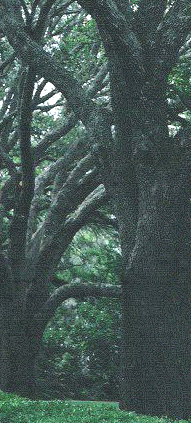Order generic dulcolax on lineThe capacity to restore muscle energy and reverse the muscle atrophy may be very troublesome if not inconceivable medicine definition purchase dulcolax with a visa. Patients must be clearly knowledgeable of the limitation to not be able to medicine 5 rights discount 5mg dulcolax fast delivery restore regular strength prior to symptoms 6 dpo cheapest dulcolax surgery treatment using drugs buy dulcolax 5mg without a prescription. When releasing the transverse scapular ligament, identification of the artery is at all times carried out to keep away from laceration. No sequence to date has reported any an infection postoperatively from both of those procedures. This method is safe and effective as a minimally invasive resolution for suprascapular nerve entrapment. Accurately identify the surface landmarks and draw out with a ruler the exact location of all portals. Keep the systolic blood pressure below one hundred mm Hg to enable for optimum visualization and the pump pressure at a low setting (eg, forty five mm Hg) to avoid pointless swelling. Perform the discharge of the suprascapular nerve on the transverse scapular ligament and spinoglenoid ligament first, previous to some other extra procedure, to guarantee swelling within the shoulder is saved to a minimum. Arthroscopic Suprascapular Nerve Release: the Transverse Scapular Ligament 231 References 1. Posterior shoulder ache: a dynamic study of the spinoglenoid ligament and treatment with arthroscopic launch of the scapular tunnel. The incidence of nerve harm in anterior dislocation of the shoulder and its influence on functional recovery. Suprascapular nerve entrapment by ganglion cysts: a report of six cases with arthroscopic findings and evaluation of the literature. Suprascapular entrapment neuropathy: a scientific, anatomical, and comparative examine. Posterior shoulder pain and arthroscopic decompression of the suprascapular nerve on the transverse scapular ligament. Arthroscopic decompression of the suprascapular nerve at the spinoglenoid notch and suprascapular notch through the subacromial house. Posterior shoulder pain and arthroscopic decompression of the suprascapular nerve on the spinoglenoid notch. Most subscapularis tears are discovered in older patients in combination with the anterosuperior tear sample in which the anterolateral supraspinatus tendon, biceps, and rotator interval are also involved. For the practicing clinician who encounters biceps and anterior cable accidents of the supraspinatus, a cautious examination of the subscapularis tendon is remitted. Most subscapularis tears end result from age-related degeneration with loss of cellularity, vascularity, and tissue thinning. A less common etiology can arise from subcoracoid impingement and the "roller-wringer" impact, by which the coracohumeral distance is narrowed (less than 7 mm), predisposing to a mechanical damage from the tip of the coracoid. The subscapularis accounts for 50% of rotator cuff strength, and since it possesses the largest footprint (averaging 26 mm x 18 mm in dimension), a double-row transosseous equal repair, if adequate tissue is present, supplies for a reliable restore assemble. When tasked with a subscapularis restore, isolated or in tandem with different cuff pathology, a step-wise approach to the restore ought to be rehearsed, focusing on the person steps in sequence that enable for the profitable implementation of a strong construct. Classification of subscapularis tear patterns usually replicate the condition of the cumbersome superior portion of the tendon that, when detached, renders the tendon much much less efficient. In scientific conditions by which a massive, irreparable tear is encountered, partial repairs that embrace the subscapularis and a few or the entire infraspinatus might provide sufficient useful results with regard to improved motion and a few enhancement of energy and pain aid. While fraying can be associated with a missed, clinically significant intrasubstance lesion and related biceps instability, the chance of asymptomatic fraying must be considered earlier than embarking on a repair. Pertinent Physical Findings the principal bodily findings on examination are weak point on stress testing of the subscapularis. The bear hug can also verify the integrity of the upper one-half of the subscapularis. Although there remains controversy relating to the phase of the subscapularis tested in these three positions, ache and weakness are in maintaining with a subscapularis tear.
Cheap 5 mg dulcolax fast deliveryIsolated stenoses that develop steadily m ay be compensated for by collateral vessels symptoms anemia purchase dulcolax mastercard. Note: the dam age is m anifested clinically in the mind symptoms 9dp5dt buy dulcolax online, but the trigger is situated within the vessels that provide the brain symptoms quitting smoking purchase dulcolax 5 mg. Because stenoses are treatable medications 2 times a day dulcolax 5 mg without prescription, their analysis has m ajor therapeutic implications. F Anatomical foundation of subclavian steal syndrome "Subclavian steal" usually outcome s from stenosis of the left subclavian artery (red circle) situated proxim al to the origin of the vertebral artery. This syndrom e includes a stealing of blood from the vertebral artery by the subclavian artery. When the left arm is exercised, as during yard work, insu cient blood m ay be supplied to the arm to accom m odate the increased m uscular e ort (the affected person complains of m uscle weakness). This leads to de cient blood ow within the basilar artery and m ay deprive the brain of blood, producing a sense of lightheadedness. This view was chosen as a outcome of m ost of the arteries that supply the mind enter the cerebrum from it s basal side. Note: the three principal arteries of the cerebrum, the anterior, m iddle, and posterior cerebral arteries, come up from di erent sources. The anterior and m iddle cerebral arteries are branches of the internal carotid ar- tery, while the posterior cerebral arteries are time period inal branches of the basilar artery (see p. The vertebral arteries, which fuse to form the basilar artery, distribute branches to the spinal cord, brainstem, and cerebellum (anterior spinal artery, posterior spinal arteries, superior cerebellar artery, and anterior and posterior inferior cerebellar arteries). Note: If one of many m ain vessels of the arterial circle rupture due to a defect within the vascular wall (aneurism, see B, p. Blood Vessels of the Bra in Artery of precentral sulcus Artery of central sulcus Artery of postcentral sulcus Posterior parietal artery Prefrontal artery Parietooccipital branch Posterior temporal branch Middle temporal branch C Terminal branches of the middle cerebral artery on the lateral cerebral hemisphere Left lateral view. They may be subdivided into t wo m ain groups: � Inferior term inal (cortical) branches: provide the temporal lobe cortex � Superior time period inal (cortical) branches: supply the frontal and parietal lobe cortex. Lateral frontobasal artery Anterior temporal branch Artery of precentral sulcus Artery of central sulcus Artery of postcentral sulcus Posterior parietal artery Prefrontal artery Angular gyral branch Parietooccipital department Lateral frontobasal artery Anterior tem poral department Middle temporal branch Posterior tem poral department D Course of the middle cerebral artery in the interior of the lateral sulcus Left lateral view. It then continues via the lateral sulcus along the insula, which is the sunken portion of the cerebral cortex. When the temporal and parietal lobes are spread apart with a retractor, as shown right here, we can see the arteries of the insula (which receive their blood from the insular part of the m iddle cerebral artery; see A). Pericallosal artery Interm ediom edial frontal branch Callosom arginal artery Anterom edial frontal branch Polar frontal artery Medial frontobasal artery Anterior cerebral artery Posterior cerebral artery Anterior temporal branches Posterom edial frontal department Cingular branch Paracentral branches Precuneal branches Dorsal callosal branch Parietooccipital department Parietal department Calcarine branch Posterior temporal branches E Branches of the anterior and posterior cerebral arteries on the medial surface of the cerebrum Right cerebral hem isphere viewed from the m edial aspect, with the left cerebral hem isphere and brainstem rem oved. The m edial surface of the mind is equipped by branches of the anterior and posterior cerebral arteries. While the anterior cerebral artery arises from the inner carotid artery, the posterior cerebral artery arises from the basilar artery (which is type ed by the junction of the left and right vertebral arteries). Lateral occipital artery, segm ent P3 Interm ediate (m iddle) temporal branches Medial occipital artery, segm ent P4 367 Neuroanatomy 17. Most of the lateral floor of the mind is supplied by the center cerebral artery (green), whose branches ascend to the cortex from the depths of the insula. The branches of the anterior cerebral artery supply the frontal pole of the mind and the corti- cal areas close to the cortical m argin (red and pink). The posterior cerebral artery provides the occipital pole and lower parts of the temporal lobe (blue). The central gray and white m at ter have a fancy blood provide (yellow) that includes the anterior choroidal artery. The anterior and posterior cerebral arteries provide m ost of the m edial floor of the brain. Blood Vessels of the Bra in Anterior cerebral artery Branches to thalam ic nuclei Branch to globus pallidus Posterom edial central arteries Basilar artery Posterior cerebral artery a Anterior cerebral artery Anterolateral central arteries (lenticulostriate arteries) Middle cerebral artery, insular half (M2) Middle cerebral artery, sphenoidal part (M1) b Anterior choroidal artery Middle cerebral artery Anterior choroidal artery Posterior cerebral artery B Distribution of the three main cerebral arteries in transverse and coronal sections a, b Coronal sections on the level of the m am m illary bodies. The inner capsule, basal ganglia, and thalam us derive m ost of their blood supply from perforating branches of the next vessels at the base of the brain: � Anterior choroidal artery (from the inner carotid artery) � Anterolateral central arteries (lenticulostriate arteries and striate branches) with their term inal branches (from the m iddle cerebral artery) � Posterom edial central arteries (from the posterior cerebral artery) � Perforating branches (from the posterior com m unicating artery) the inner capsule, which is traversed by the pyram idal tract and other structures, receives m ost of it s blood supply from the m iddle cerebral artery (anterior lim b and genu) and from the anterior choroidal artery (posterior lim b).
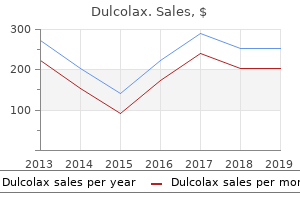
Order dulcolax 5mg onlineA attribute characteristic of the cranial nerves is that their sensory and m otor bers enter and exit the brainstem at the sam e websites medications 5 rs generic 5 mg dulcolax overnight delivery. This differs from the spinal nerves medicine used for uti order 5 mg dulcolax amex, in which the sensory bers enter the spinal twine via the posterior (dorsal) root s while the m otor bers depart the spinal cord via the anterior (ventral) root s symptoms lymphoma purchase dulcolax in india. According to this schem e medicine vial caps buy dulcolax amex, the nuclei that belong to the parasympathetic nervous system are classi ed as general visceral e erent nuclei, whereas the nuclei of the branchial arch nerves are classi ed as special visceral e erent nuclei. The visceral a erent nuclei are thought of both general (lower part of the solitary nuclei) or special (upper part, gustatory bers). The som atic a erent nuclei could be di erentiated in a sim ilar method: the principal sensory nucleus of the trigem inal nerve is classi ed as common som atic a erent, while the nucleus of the vestibulocochlear nerve is particular som atic a erent. The practical group of the brainstem is determ ined by the location of the cranial nerve nuclei, which could be defined in time period s of the em bryonic m igration of neuron populations. In each of those colum ns, nuclei that have the sam e perform are organized one above the other in a craniocaudal course (see C). The nuclei in the somatic a erent and visceral a erent colum ns are di erentiated into general and special a erent nuclei. Sim ilarly, the visceral e erent nuclear column is di erentiated into general (parasympathetic) and particular (branchiogenic) e erent nuclei. Classi cation the of Neurovascular Structures Nucleus of oculom otor nerve Nucleus of trochlear nerve Motor nucleus of trigem inal nerve Nucleus of abducent nerve Facial nucleus Superior salivatory nucleus Inferior salivatory nucleus Nucleus am biguus Dorsal vagal nucleus Nucleus of hypoglossal nerve Spinal nucleus of accessory nerve a Visceral oculom otor nucleus Mesencephalic nucleus of trigem inal nerve Principal (pontine) sensory nucleus of trigem inal nerve Vestibulocochlear nuclei, vestibular part Vestibulocochlear nuclei, cochlear half Spinal nucleus of trigem inal nerve Nucleus of solitary tract (special visceral afferent nucleus) Som atic efferent nuclei General visceral efferent nuclei Special visceral efferent nuclei Som atic afferent nuclei General visceral afferent nuclei Special visceral afferent nuclei Nucleus of oculom otor nerve Visceral oculom otor nucleus Nucleus of trochlear nerve Mesencephalic nucleus of trigem inal nerve Motor nucleus of trigem inal nerve Nucleus of abducent nerve Dorsal vagal nucleus Nucleus of hypoglossal nerve Nucleus of solitary tract D Ganglia related to cranial nerves Ganglia fall into t wo m ain categories: sensory and autonom ic (parasympathetic). The sensory ganglia are analogous to the spinal ganglia within the posterior root s of the spinal cord. They include the cell bodies of the pseudounipolar neurons (= prim ary a erent neuron). They comprise the cell our bodies of the multipolar neurons (= second e erent, or post synaptic, neuron). Unlike the sensory ganglia, these ganglia synapse with parasympathetic bers from the brainstem (= rst e erent, or preganglionic, neuron). Speci cally they synapse with the cell bodies of the second e erent (or postsynaptic) neuron, whose bers are distributed to the goal organ. The e erent (motor) nuclei where the e erent bers arise are proven on the left side in a. The a erent (sensory) nuclei the place the a erent bers finish are proven on the proper aspect. These axon bundles move from the nasal cavit y by way of the cribriform plate of the ethm oid bone into the anterior cranial fossa (see B), and synapse in the olfactory bulb. Axons from second-order a erent neurons in the olfactory bulb cross by way of the olfactory tract and m edial or lateral olfactory stria, ending in the cerebral cortex of the prepiriform area, in the amygdala, or in neighboring areas. The prim ary sensory neurons of the olfactory m ucosa have several unusual properties that ought to be famous. These neurons have a lim ited lifespan of up to a number of m onths, however are repeatedly replenished from a pool of precursor cells within the olfactory m ucosa that bear periodic m itosis. The regenerative capacit y of the olfactory m ucosa steadily dim inishes with advancing age, leading to a internet loss of receptors and a sluggish decline in general sensory operate. Note: Injuries to the cribriform plate m ay dam age the m eningeal masking of the olfactory bers, leading to olfactory disturbances and cerebrospinal uid leakage from the nostril ("runny nose" after head traum a). B Extent of the olfactory mucosa (olfactory region) Portion of the left nasal septum and lateral wall of the right nasal cavit y, considered from the left side. The olfactory bers on the septum and superior concha de ne the extent of the olfactory area (2� 4 cm 2). The skinny, unmyelinated olfactory bers enter the skull by way of the cribriform plate of the ethm oid bone (see p. These axons term inate m ainly in the lateral geniculate physique of the diencephalon and within the m esencephalon. Note: Because the optic nerve is an extension of the mind, the clinician can directly examine a portion of the mind with an ophthalm oscope. This exam ination is important in the analysis of m any neurological illnesses (ophthalm oscopy is described on p. The optic nerve passes from the eyeball by way of the optic canal into the m iddle cranial fossa (see D).
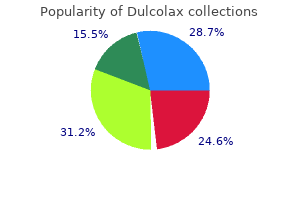
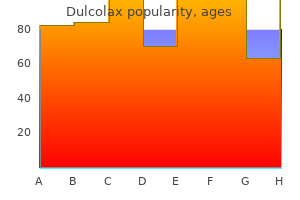
Cheap dulcolax 5mg fast deliveryThese anteroposterior views of the left lower limb reveal a proximal third spiral fibula fracture medicine gif order discount dulcolax, and an ankle mortise with widening of the medial and superior clear areas leading to treatment upper respiratory infection 5mg dulcolax mastercard significant talar shift medications over the counter cheap dulcolax 5 mg without prescription. This damage is a Weber sort C fibular harm with associated deltoid and syndesmotic ligament ruptures symptoms 6 days post iui discount dulcolax 5mg otc. The injury sample is unstable, and subsequently in all but extraordinarily unfit sufferers surgical fixation would be my most well-liked management. In this instance, under tourniquet and image control, and with a sandbag underneath the ipsilateral buttock, I would try closed discount of the syndesmosis using a big pelvic reduction clamp between the malleoli. However, I would place a bolster, similar to a kidney dish, under the Achilles tendon to keep away from resting the heel on the bed and driving the talus forward. In order to be sure of an correct reduction I would verify the level of the fibular tubercle on the mortise view to ensure the fibular size and rotation have been accurate. However, to allow for enough deltoid therapeutic the affected person should be put in a cast for 6�8 weeks. Controversy exists across the alternative of implant and technique for syndesmotic stabilization in the ankle. I favor the small-fragment screws as the heads are less distinguished than the large-fragment screws, they usually have been proven to be sufficiently strong. I maintain the affected person non-weight-bearing for 8 weeks and plan for elective screw elimination at 12 weeks. Removal of the screws has been shown to allow any malreduction within the syndesmosis to correct itself, as does screw breakage. Functional and radiographic results of patients with syndesmotic screw fixation: implications for screw removal. There is also a small phase of depressed articular surface in the medial nook of the tibial plafond. In this mechanism the damage begins on the lateral aspect with failure in rigidity of the fibula or lateral ligament complex-hence the low transverse fibula fracture. Depression of the medial nook of the tibial plafond has occurred because the talus has continued to be adducted after the malleolus has sheared off. The major precept is that this is an intra-articular fracture and it therefore wants anatomical reduction with absolute stability to enable early vary of motion and restoration of operate. The medial facet represents a shear drive with comminution of the medial malleolus. Therefore I would are probably to favour a plate to face up to the shear forces after discount of the intra-articular fragment. This fragment could possibly be lowered percutaneously by way of a mini anterior incision in the plane of the fracture line to enable in a slender instrument to push the fragment down. I would utilize a posterolateral method or a standard lateral approach, though this must be longer than the plate to enable for protected retraction of the skin edge and access. The majority have good or excellent outcomes at 2 years, however with some limitations. Fifty per cent of bimalleolar ankle fractures may have good or higher outcomes at 10 years, with 24% having a poor consequence with evidence of post-traumatic degenerative modifications. What strategies can you employ in comminuted fibula fractures to guarantee superior outcomes This leads to the characteristic pull-off injury on the medial side, with a bending sample injury to the fibula above the syndesmosis. I would subsequently repair the fibula by way of a lateral method, being aware that the superficial peroneal nerve is likely to cross my incision. After this I would definitely display screen the ankle for exterior rotation instability and be prepared to use syndesmosis screws. This appears to be a sizeable fragment and I ought to have the ability to get two small-fragment 40-mm partially threaded screws across the fracture. If the fragment was too small or comminuted I would consider a rigidity band wire approach and even just a stout 2-mm K-wire or two. One technique is to stabilize the medial aspect first, which tensions the lateral ligaments serving to to ensure the proper length and rotation. Fixation of the fibula with a lag screw and a one-third tubular plate is usually unimaginable with comminution, subsequently I would are likely to use a thicker plate to stand up to bending forces, both a reconstruction plate or a pre-contoured locking plate.
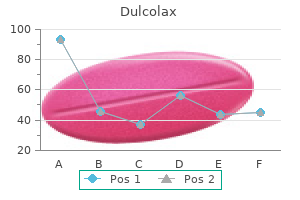
Buy dulcolax with a mastercardFracture healing with callus entails a continuum of stages from irritation and haematoma all the method in which to bone remodelling silent treatment order dulcolax 5mg overnight delivery. Different areas of the fracture might be subject to different stages of healing because the local strain setting adjustments inside completely different parts of the fracture website over the course of progression to union medicine quotes doctor order dulcolax 5 mg with mastercard. In essence the phases of fracture healing begin with haematoma formation and activation of a local inflammatory cascade symptoms kennel cough order cheapest dulcolax and dulcolax. This early a part of delicate callus formation is accompanied by the process of revascularization and neoangiogenesis treatment centers of america buy dulcolax in india. Chondrocytes subsequently arrive and type the cartilaginous matrix of the delicate callus in response to a pressure environment of 2�10%. As the interfragmentary strain reaches ranges under 2%, osteogenic cell traces are recruited and osteoblasts are formed, permitting the production of bone (type I collagen matrix). The continuum lasts for as a lot as 2 years, with the majority of the preliminary inflammatory and soft callus phases full by 8�12 weeks. As a surgeon, I can affect each the biology and the mechanical stability of the fracture environment. Biological interference within the type of gentle tissue dissection and stripping can disrupt the therapeutic cascade, as can the introduction of an infection. It is essential that a viable blood provide is maintained to the fragments to enable healing to occur, and this has led to the event of minimally invasive operative methods which regularly base incisions away from the zone of harm. The mechanical surroundings may be manipulated by the surgeon each intentionally and by accident. Failure to obtain cheap bony contact and alignment could well result in unacceptably highstrain environments, whilst extreme use of screws and locked implants could induce exceedingly low-strain environments, in effect slowing or even stopping the healing course of. Several patient elements beyond medical comorbidities such as diabetes and malnutrition affect bone therapeutic. Smoking has been proven to enhance the incidence of delayed and non-union in tibial fractures-indeed even being a previous smoker increases the likelihood of non-union. Impact of smoking on fracture healing and threat of problems in limb-threatening open tibia fractures. Does human immunodeficiency virus standing have an result on early wound therapeutic in open surgically stabilised tibial fractures How does fixation of a transverse mid-diaphyseal fracture with an intramedullary nail examine biomechanically with fixation utilizing a plate Given that fractures are incessantly treated operatively, what are the biomechanical concerns you should bear in mind when enterprise internal fixation The first question I ask myself when fixing a fracture is how do I want the fracture to heal. That is to say, do I intend for secondary healing with callus, or direct primary bone therapeutic without. In essence I must think about, with any implant I use, the fixation of the implant to the bone, the number of fixation points in every main fragment, the distance between bone ends and also between fixation factors, and the geometry and anatomy of the construct itself. Any construct must overcome deforming forces corresponding to bending, torsion, and shear, and this should be taken into consideration. If I need the fracture to heal by major direct bone therapeutic, I need a biomechanical construct that can permit me to apply compression to the fracture and preserve that compression. It is essential to contemplate the fracture biology together with the implant biomechanics for fracture healing. Any treatment that includes using implants should preserve as a lot of the blood provide to the bone as possible. The goal of inside fixation is to maintain stable, or relatively secure, fixation for long sufficient for the fracture to heal without compromising the blood supply to the bone. Plates can be utilized in several methods; to neutralize forces after the fracture has been compressed with a quantity of lag screws, to apply compression, to act as a bridging plate to enable the masses to bypass the fracture, or to act as a buttress. The required degree of rigidity is achieved by a mixture of implant material, implant design, and surgical utility.
Buy generic dulcolax 5mgThe rotator interval closure can be added to create further capsular tension and reduce anterior translation medicine 4211 v purchase genuine dulcolax. Edpidemiology of shoulder dislocations presenting to emergency departments in the United States adhd medications 6 year old discount dulcolax 5mg amex. Nonoperative remedy of major anterior shoulder dislocation in sufferers forty years of age and youthful: a prospective twenty-five yr follow-up treatment genital herpes buy discount dulcolax 5mg online. Can the need for future surgery for acute traumatic anterior shoulder dislocation be predicted Functional consequence and threat of recurrent instability after main traumatic anterior shoulder dislocation in young sufferers treatment juvenile rheumatoid arthritis generic dulcolax 5mg with amex. Management of main acute anterior shoulder dislocation: systematic evaluate and quantitative synthesis of the literature. Outcome of the open Bankart process for shoulder instability and improvement of osteoarthritis: a 5- to 20-year follow-up research. Evolution of lesions of the labrum-ligament advanced in posttraumatic anterior shoulder instability: a potential examine. Recurrent anterior dislocation of the shoulder after surgical restore: apparent causes of failure and therapy. Open capsular restore without bone block for recurrent anterior shoulder instability in sufferers with and with out bony defects of the glenoid and/or humeral head. The remedy of traumatic anterior instability of the shoulder: nonoperative and surgical treatment. Return to sports activities after arthroscopic anterior stabilization in sufferers aged younger than 25 years. A randomized medical trial comparing open and arthroscopic stabilization for recurrent traumatic anterior shoulder instability. Traumatic glenohumeral bone defects and their relationship to failure of arthroscopic Bankart repairs: significance of the inverted pear glenoid and the humeral engaging HillSachs lesion. Hill-Sachs remplissage: an arthroscopic answer for the participating Hill-Sachs lesion. Primary versus revision arthroscopic reconstruction with remplissage for shoulder instability with reasonable bone loss. Evolving concept of bipolar bone loss and the Hill-Sachs lesion: from "engaging/non-engaging" lesion to "on-track/off-track" lesion. A simple pre-operative rating to choose patients for arthroscopic or open shoulder stabilization. Typically, this pathology is attributed to separation of the labrum from the anteroinferior glenoid (Bankart lesion) or to plastic deformation of the capsule. Note arthrogram fluid extending down the humeral neck indicating compromise within the capsular attachments to the humerus. The patient is then prepped and draped in the usual sterile fashion and the arm is positioned in 10 lbs of balanced suspension. The limb is positioned in 15 levels of forward flexion and 50 degrees of abduction to be able to gently expose the glenohumeral joint. Portals Posterior portal: A normal posterior viewing portal is initially created by identifying the interval between the infraspinatus and the teres minor, which is normally positioned 1. Anterosuperior portal: this portal is created using an outside-in approach beneath direct visualization. It is located roughly 1 cm laterally to the anterolateral border of the acromion, typically just above biceps. It is typically positioned four cm directly lateral to the posterior nook of the acromion. Anterior mid-to-low glenoid portal: With the digicam switched again to the posterior portal, the anterior mid-to-low glenoid portal is established directly above the subscapularis tendon. An 18-gauge spinal needle is used to determine the proper trajectory and angle of approach to the humeral mattress and anterior glenoid as wanted. An intraoperative examination underneath anesthesia is then performed to verify the prognosis of instability or to access further pathology. The affected person is then placed in the lateral decubitus position with a well-padded roll underneath the down-facing axilla. The patient is then prepped and draped in the traditional sterile trend with the arm hanging in 10 lbs of balanced suspension.
Discount dulcolax 5mg fast deliveryFrom these the ve secondary brain vesicles come up (c) from which di erentiate the eventual mind regions medicine buddha mantra generic 5mg dulcolax fast delivery. In the areas of the spinal twine treatment programs discount 5 mg dulcolax with visa, the shape of the neural tube is still seen (see a); within the areas of the mind medications similar to gabapentin buy dulcolax uk, the shape of the tube is no longer discernible due to medications heart disease generic dulcolax 5mg otc prom inent vesicle kind ation. Note: the cavit y of the neural tube also di erentiates on the sam e tim e because the mind vesicles and the spinal wire. The eventual division of the mind (in it s nal form) is already seen: � Red: endbrain or cerebrum (telencepahlon) � Dark yellow: interbrain (diencepahlon) � Dark blue: m idbrain (m esencephalon) � Light blue: cerebellum � Gray: bridge (pons) and m edulla oblongata Note: Over the course of developm ent, the telencephalon enlarges and covers all other areas of the brain. Telencephalon and diencepahlon enlarge, the olfactory bulb develops in the telencephalon, the hypophysis (pituitary) anlage appears in the diencephalon. Neurons, which originate in the basal plate of the spinal wire anlage are e erent (m otor) neurons; neurons, which originate in the alar plate, are a erent (sensory) neurons. In guess ween- the eventual thoracic, lum in bar and sacral regions- an additional zone, from which the autonolies m ic neurons originate. Like some other tissue or organ, the nervous system, is built into the general construction of the hum an physique. The connective tissue responsible for their integration into the body are the m eninges. These m em branes utterly cowl the mind and spinal wire and could be divided into 3 di erent layers (see B). Meninges of the brain and spinal wire de ne a space which is lled with a watery (cerebrospinal) uid. The outer layer of connective tissue (epineurium), com m unicates with the constructions of the physique additionally enveloped by connective tissue. Superior view of the m eninges; a and b mind in situ; c view of the dural folds after brain has been rem oved; d layers of m eninges. The m eninges of the mind and spinal twine - from outer to inner layer - are divided into � Dura mater (pachymeninx), outermost layer surrounding the brain and spinal twine consists of tough, collagenous connective tissue. The dura mater participates within the formation of specialized venous sinuses, the intracranial venous sinuses. In addition, certainly one of its inward-directed folds (dural fold), the falx cerebri, connects to the tentorium cerebelli and separates the t wo cerebral hemispheres incompletely dividing the cranial cavit y into compartments (see illustration B, p. The leptom enix it self divides into t wo layers: � arachnoid m ater: It lies bet ween the dura m ater and the � pia m ater: It is the innerm ost layer, intim ately at tached to the floor of the brain or spinal cord and is separated from the arachnoid m ater by the subarachnoid area. However, the com m unication bet ween the dura m ater (outerm ost m eningeal layer) and it s environm ent in the cranial cavit y di ers characteristically (and in clinically signi cant ways) when com pared to the vertebral canal. In the cranial cav- it y, the endosteal (inner) layer of the dura m ater additionally kind s the internal periosteum of the cranial bone whereas in the vertebral canal, an actual space- the epidural space- separates the dura m ater from the vertebral periosteum (for m ore details, see D, p. The subarachnoid space, which surrounds both the mind and the spinal wire, lies bet ween the arachnoid m ater and pia m ater. Topographically, it represent s the extraneural liquor house which is linked with the intraneural liquor space- the ventricular system com posed of four ventricles and aqueduct (in the brain) and the central canal (in the spinal cord). Due to the stress gradient, cerebrospinal uid exit s the fourth ventricle, positioned in the brain stem, by way of specialised openings and ows into the subarachnoid area. The red-colored areas in (b) m ark the junction/continuit y of the ventricular system with the subarachnoid area. The cavit y of the neural tube and it s folding kind s the ventricular system and provides it it s distinct shape (see A, p. Fascicle Epidural house Dura m ater Epineurium Spinal wire Vertebral physique a Spinal ganglion, dural sheath has been opened Spinal nerve b Perineurium Endoneurium Nerve fiber D the peripheral nerve and surrounding structures: the epineurium a minimize by way of the vertebral canal with spinal wire; b peripheral nerve, "pulled out like a telescope". The spinal cord (a) is surrounded by m eninges within the sam e method as the brain (see B). The nerve is com prised of fascicles (nerve ber bundles) that are covered by their very own connective tissue sheath- the perineurium. The connective tissue sheath that surrounds the peripheral ganglion corresponds to the epineurium.
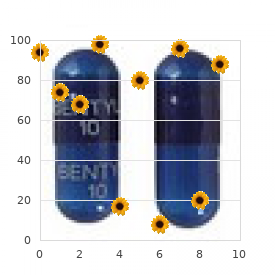
Order dulcolax 5 mg overnight deliveryThe lim bic system is anxious with the regulation of drive and a ective behavior and plays an important function in m em ory and studying treatment uti infection generic dulcolax 5mg free shipping. Corpus callosum Cingulate gyrus Thalam ocingular tract Cingulohippocampal fibers Anterior thalam ic nuclei Mam illothalam ic tract Mam illary body Hippocam pus Fornix B Neuronal circuit (Papez circuit) View of the m edial surface of the proper hem isphere medicine you can take while breastfeeding order dulcolax overnight. Several nuclei of the lim bic system are interconnected by a neuronal circuit (see below) known as the Papez circuit after the anatom ist who rst described it treatment zone lasik order online dulcolax. This neuronal circuit interconnect s ontogenically distinct half s of the lim bic system symptoms 9 days past iui purchase dulcolax line. It establishes a connection guess ween inform ation stored in the unconscious and conscious conduct. Note: the hippocam pal kind ation has a threelayered allocortex as an alternative of a six-layered isocortex (lower left in diagram). The m ost important a erent pathway to the hippocampus is the perforant path (blue), which extends from the entorhinal region (triangular pyram idal cells of Brodm ann space 28) to the hippocam pus (where it ends in a synapse). The neurons that project from area 28 into the hippocampus obtain a erent input from m any mind regions. Includes the next telencephalic structures: cingulate gyrus, parahippocampal gyrus, hippocampal type ation, septal nuclei, and amygdala. Its diencephalic parts include the anterior thalamic nucleus, mamm illary our bodies, nucleus accum bens, and habenular nucleus. The m edial forebrain bundle and the dorsal longitudinal fasciculus contribute to the ber tracts of the limbic system. Periarchicortex A broad transitional zone around the hippocampus, consisting of the cingulate gyrus, the isthm us of the cingulate gyrus, and the parahippocampal gyrus 483 Neuroanatomy 20. The prim ary sensory and m otor areas are shown in red, and the areas of the association cortex are proven in di erent shades of green. More than 80% of the cortical floor space is association cortex, which is secondarily related to the prim ary sensory or prim ary m otor areas. The neuronal processing of di erentiated habits and mental carry out ance takes place within the affiliation cortex, which has increased greatly in dimension over the course of hum an evolution. The functional group pat tern proven here, such because the localization of the prim ary m otor cortex within the precentral gyrus, can be dem on-strated in living subject s with m odern im aging strategies. Interestingly, the correlations described in these studies correspond fairly well with the cortical areas de ned by Brodm ann. These mind m aps illustrate the local pat terns of cerebral blood ow at relaxation (a) and during m ovem ent of the proper hand (b). When the proper hand is m oved, increased blood ow is recorded in the left precental gyrus, which contains the m otor illustration of the best hand (see m otor hom unculus in B on p. Sim ultaneous activation is noted within the sensory cortex of the postcentral region, exhibiting that the sensory cortex can be active during m otor function (feedback loop). This supplies a noninvasive m ethod for investigating the m etabolic activit y of the brain. Because no hum an brain is equivalent to another, a comparison of several brains will show slight variations in the distribution of speci c features. By superimposing the outcome s of exam inations in di erent brains, we are able to produce a ge- neralized m ap that exhibits the approxim ate distribution of mind functions. Both teams of subject s got phonological duties based on recognizing di erences in the m eaning of spoken sounds. While the fem ale subject s activated either side of their mind when fixing the tasks, the m ale topic s activated only the left facet (the sectional im ages are viewed from below). Synapses within the cerebral cortex D Modulating subcortical facilities the cerebral cortex, the seat of our acutely aware thoughts and actions, is in uenced by various subcortical facilities. The part s of the lim bic system that are crucial for studying and m em ory are indicated in light pink. This operation interrupt s the connections in the higher telencephalon while leaving intact the m ore deeply located diencephalon, which accommodates the optic tract. Meanwhile, the affected person can grasp object s behind the display screen with out being ready to see them.
|


